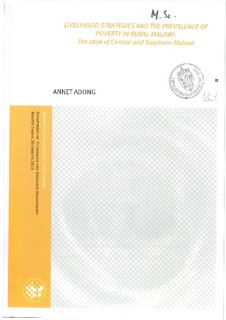| dc.description.abstract | Rural households in developing countries like Malawi often take on a diversity of
livelihood activities in an attempt to smooth consumption and improve on their general
wellbeing. However, their choices to any of the livelihood strategies (combination of
different livelihood activities) are conditioned by several factors ranging from asset endowment, geographical location and other exogenous factors like shocks. This paper identifies the livelihood strategies existing in Southern and Central Malawi using cross sectional data of 378 households. Subsequently, it looks at the factors limiting household’s choices to particularly higher return livelihood strategies and the prevalence of poverty within these strategies. It uses the Sustainable Livelihoods framework for this
analysis. Using factor and cluster analysis based on the labor shares, it identifies five
distinct livelihood strategies. However, when factor and cluster analysis based on the net income shares are used, three livelihood strategies are identified. For other analysis, it adapts the livelihood strategies identified under income shares and finds that the forest and off farm worker strategy is inferior to the non farm business strategy and mixed livelihood strategy. The prevalence of poverty based on Foster Greer Thorbecke poverty indices and the Three I’s of poverty also show that the forest and off farm worker strategy
has the highest prevalence of poverty followed by the mixed strategy and lastly the nonfarm business strategy. Using the multinomial logit model, the results indicate that the asset endowments particularly education, livestock units, labor, gender and district locations (Thyolo and Zomba districts in relation to Lilongwe) are crucial factors conditioning household’s choices to livelihood strategies. Programmes aimed at poverty reduction should therefore be directed to the forest and off farm livelihood strategy. Additionally, policies such as education and distribution of the livestock assets become relevant for this subgroup. Of at most importance however, is the need to create a balance within the districts in terms of improved infrastructural access. | en_US |
